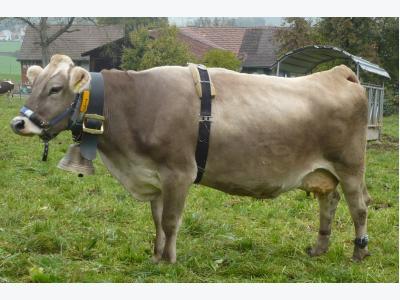Cow bells and their effect on cow behaviour
In alpine regions cows are often equipped with bells. But how do cows experience wearing these bells? Swiss researchers delved into this issue.
 Diseases of Cattle: Lumpy Jaw
Diseases of Cattle: Lumpy Jaw Actinomycosis or lumpy jaw produces immovable hard swellings on the upper and lower jawbones of cattle, commonly at the central molar level.
 Diseases of Cattle: Listeriosis
Diseases of Cattle: Listeriosis Listeriosis, a disease of the central nervous system, is caused by the bacterium Listeria moncytogenes. This bacterium can live almost anywhere--in soil
 Diseases of Cattle: Leptospirosis
Diseases of Cattle: Leptospirosis At least five species of leptospira, a corkscrew-like bacteria, affect cattle in the United States. The most common species affecting cattle is L. pomona.
 Diseases of Cattle: Johne's Disease
Diseases of Cattle: Johne's Disease Johne's Disease (pronounced YO-knees), or paratuberculosis, is a chronic wasting disease that causes considerable production losses in adult cattle
 Diseases of Cattle: Internal parasites
Diseases of Cattle: Internal parasites Calves under one year of age are more susceptible than older cattle who frequently have been exposed to the parasites and have developed a degree of immunity.
 Diseases of Cattle: External parasites
Diseases of Cattle: External parasites Horn flies, face flies, stable flies, ticks, lice and mites are the major external parasites in beef cattle about half the size of house flies and are dark gray
 Diseases of Cattle: Infectious bovine rhinotracheitis
Diseases of Cattle: Infectious bovine rhinotracheitis Infectious bovine rhinotracheitis (commonly called IBR or red nose) is an acute, contagious virus disease of cattle. Often implicated as an infection
 Diseases of Cattle: Grass tetany
Diseases of Cattle: Grass tetany Grass tetany is a serious, often fatal metabolic disorder characterized by low levels of magnesium in the blood serum of cattle.
 Diseases of Cattle: Footrot
Diseases of Cattle: Footrot Footrot occurs in cattle of all ages, but it is most common in adults. The disease is seen year-round, but there is increased incidence in the wet summer
 Diseases of Cattle: Foot-and-Mouth
Diseases of Cattle: Foot-and-Mouth Foot-and-Mouth Disease is a severe, highly communicable disease of cattle, pigs, sheep, goats and deer. It is caused by one of the smallest disease producing
 Mycotoxins in corn silage threaten ruminant performance
Mycotoxins in corn silage threaten ruminant performance 2015 corn harvest found to have moderate to high risk levels of multiple toxins, calves especially susceptible
 Crude protein levels low in 2016 silage crops
Crude protein levels low in 2016 silage crops Find out how to create the best quality silage. In the first and second cuts, average crude protein levels are 14.1 and 14.2 percent, respectively.
 Live yeast helps manage heat stress in dairy cows
Live yeast helps manage heat stress in dairy cows Rumen modifiers, such as live yeast, can help alleviate the drawbacks of heat stress on digestive comfort and help preserve dairy performance
 Climate change increasing heat stress in dairy cows
Climate change increasing heat stress in dairy cows Dairy cows in traditionally cooler climates may have to cope with the effects of climate change – leaving producers combating the effects of heat stress.
Heat stress is a natural phenomenon that affects dairy cows and other domestic animals in tropical, sub-tropical and often in temperate regions of the world
 Increasing cow feed profitability with sugar
Increasing cow feed profitability with sugar Research that has been done appears to indicate that using sugar in dairy cow feed has the potential to produce good quality meat and milk.
 Seaweed mineral supplement for organic dairy cows
Seaweed mineral supplement for organic dairy cows Study shows that mineral status of organic dairy cows significantly improved with the introduction of algae supplement. Algae supplement significantly improved
 Why don't dairy cows like fats and oils?
Why don't dairy cows like fats and oils? Dairy cows evolved to consume large quantities of fresh grass that contains negligible amounts of fats. As such, the risk for metabolic disorder increases
 5 steps to increase dairy cow dry matter intake
5 steps to increase dairy cow dry matter intake Increasing dry matter intake in milk cows is a measure of success for any dairy nutritionist, and this five-step program provides a basic guideline towards this
